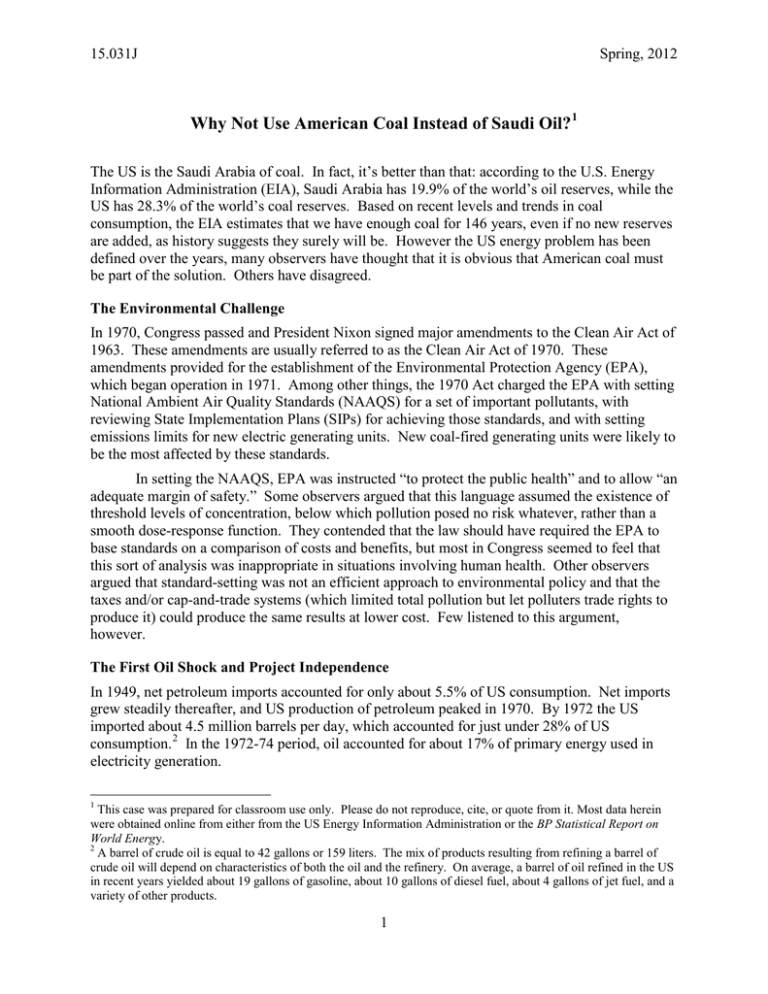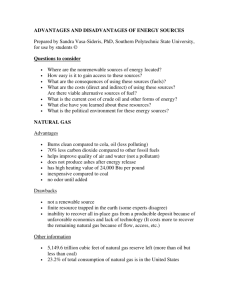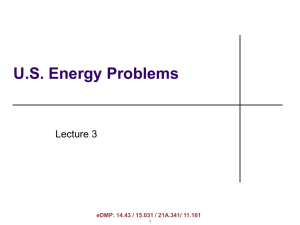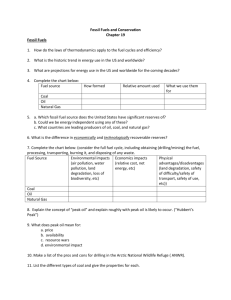Why Not Use American Coal Instead of Saudi Oil?
advertisement

15.031J Spring, 2012 Why Not Use American Coal Instead of Saudi Oil? 1 The US is the Saudi Arabia of coal. In fact, it’s better than that: according to the U.S. Energy Information Administration (EIA), Saudi Arabia has 19.9% of the world’s oil reserves, while the US has 28.3% of the world’s coal reserves. Based on recent levels and trends in coal consumption, the EIA estimates that we have enough coal for 146 years, even if no new reserves are added, as history suggests they surely will be. However the US energy problem has been defined over the years, many observers have thought that it is obvious that American coal must be part of the solution. Others have disagreed. The Environmental Challenge In 1970, Congress passed and President Nixon signed major amendments to the Clean Air Act of 1963. These amendments are usually referred to as the Clean Air Act of 1970. These amendments provided for the establishment of the Environmental Protection Agency (EPA), which began operation in 1971. Among other things, the 1970 Act charged the EPA with setting National Ambient Air Quality Standards (NAAQS) for a set of important pollutants, with reviewing State Implementation Plans (SIPs) for achieving those standards, and with setting emissions limits for new electric generating units. New coal-fired generating units were likely to be the most affected by these standards. In setting the NAAQS, EPA was instructed “to protect the public health” and to allow “an adequate margin of safety.” Some observers argued that this language assumed the existence of threshold levels of concentration, below which pollution posed no risk whatever, rather than a smooth dose-response function. They contended that the law should have required the EPA to base standards on a comparison of costs and benefits, but most in Congress seemed to feel that this sort of analysis was inappropriate in situations involving human health. Other observers argued that standard-setting was not an efficient approach to environmental policy and that the taxes and/or cap-and-trade systems (which limited total pollution but let polluters trade rights to produce it) could produce the same results at lower cost. Few listened to this argument, however. The First Oil Shock and Project Independence In 1949, net petroleum imports accounted for only about 5.5% of US consumption. Net imports grew steadily thereafter, and US production of petroleum peaked in 1970. By 1972 the US imported about 4.5 million barrels per day, which accounted for just under 28% of US consumption. 2 In the 1972-74 period, oil accounted for about 17% of primary energy used in electricity generation. 1 This case was prepared for classroom use only. Please do not reproduce, cite, or quote from it. Most data herein were obtained online from either from the US Energy Information Administration or the BP Statistical Report on World Energy. 2 A barrel of crude oil is equal to 42 gallons or 159 liters. The mix of products resulting from refining a barrel of crude oil will depend on characteristics of both the oil and the refinery. On average, a barrel of oil refined in the US in recent years yielded about 19 gallons of gasoline, about 10 gallons of diesel fuel, about 4 gallons of jet fuel, and a variety of other products. 1 15.031J Spring, 2012 In October 1973, the Arab members of OPEC (the price-and output-setting Organization of Petroleum Exporting Countries) announced a boycott of the US (and, later, the Netherlands) in response to its having supported Israel in the then-ongoing Yom Kippur war with its Arab neighbors. However, since oil is traded globally and tanker cargoes can be bought, sold, and redirected at sea with a few telephone calls, the US nonetheless obtained essentially all the oil it demanded at market prices (as did the Netherlands). OPEC subsequently announced price increases and output cuts. As a consequence, between 1972 and 1974 the world experienced what is generally termed the first oil price shock: the price of crude oil increased by over 460%. (See the figure at the end of this note.) In November, 1973, shortly after the end of the Yom Kippur war, President Nixon announced “Project Independence,” an effort to make the nation independent of imported energy by 1980. Some analysts argued that this was not a sensible goal. They argued that not only had the US just seen that embargoes don’t work in a world market, but even if they did work, an effective embargo against our allies would affect us even if we were energy independent. Thus, they concluded, even if we used no imported oil, oil would continue to shape our foreign policy to some extent. Further, they contended, even though oil imports obviously involve Americans sending money abroad, the key to reducing the impact of oil price shocks on consumers is to develop cheaper sources of energy. Finally, they argued, we are indeed vulnerable to price shocks in the world oil market, but reducing that vulnerability involves reducing the use of oil, not the use of imported oil. Despite these arguments, the goal of energy independence has remained very popular in political circles ever since the 1970s. CAFE Standards In the aftermath of the first oil price shock, there was interest in reducing US use of oil in general by increasing efficiency in the transportation sector. Legislation signed by President Ford in 1975 established the Corporate Average Fuel Economy (CAFE) program, which put a lower limit on the average mileage of new passenger cars sold by each auto company in the US beginning in 1978. A less stringent limit was placed on the average mileage of new light-duty trucks (which came to include minivans and SUVs) beginning in 1979. The initial legislation specified that these limits were to be adjusted by the National Highway Transportation Safety Administration (NHTSA) over time in light of technical developments and other considerations. Japan and most European nations had long been almost totally dependent on imported oil for transportation fuel. They had mainly relied on high taxes on gasoline and diesel fuel in order to limit consumption, though they also came to adopt mileage limits. When the CAFE program was proposed, some observers argued that taxes on gasoline and diesel fuel should be raised instead. They argued that tax increases would affect all drivers, not just those who purchased new cars. Moreover, they contended, improving automobile vehicle mileage reduces cost per mile driven and thus encourages driving – perhaps enough to increase fuel consumption. Other observers doubted that consumers would respond much to changes in fuel prices and argued that forcing the auto companies to produce more efficient vehicles was much more likely to reduce oil consumption. Mileage standards for cars were increased through 1985 and for light duty trucks through 1984. A 2002 report of the National Research Council concluded that “for the entire light duty fleet … between 1975 and 1984 technology improvements were concentrated on fuel economy: 2 15.031J Spring, 2012 it improved by 62% without any loss of performance as measured by 0-60 mph acceleration times.” 3 The 1985 car standard was still in effect in 2009, while the light-duty truck standard had been increased by only 1 mile per gallon between 1984 and 2005. The National Research Council report concluded that after 1985, technology improvements were concentrated on performance and other vehicle attributes: between 1985 and 2000, vehicles became 20% heavier, and 0-60 times fell by 25%. The Second Oil Shock Oil prices remained high by historic standards during the 1974-78 period until the 1979 Islamic Revolution in Iran again disrupted supply, and the world experienced the second oil price shock: largely as a consequence of events in Iran, between 1978 and 1980 crude oil prices increased by another 260%. Despite these price increases and despite Project Independence, US net imports rose by over 220% between 1972 and 1980, reaching almost five million barrels a day. In 1980, about 41% of oil and other petroleum products (by energy content) that was consumed in the US was imported. About 8.5% was used to generate electricity, accounting for 14% of primary energy used in electricity generation. Fifty-one percent of oil was used in transportation, where it accounted for 97% of energy input. 4 Synthetic Fuels In December, 1980, after the election he had lost to Ronald Reagan but before Reagan’s inauguration, President Jimmy Carter signed legislation establishing the US Synthetic Fuels Corporation. The Corporation was authorized to spend up to $88 billion to provide subsidies to the private sector for commercial-scale plants that would use coal and other “unconventional” resources (like tar sands and oil shale) to produce alternatives to imported oil and natural gas. The idea of using coal as a feedstock to produce an oil substitute was hardly new. Germany has an abundance of coal but essentially no oil, and German scientists worked to develop fundamental coal-to-liquids (CTL) technologies in the 1910s and 1920s. From 1928 through 1952, the US Bureau of Mines experimented with a variety of these technologies and built two pilot plants that produced synthetic fuel. Germany and Japan made intensive use of the Fischer-Tropsch process, first developed in Germany in the 1920s, to produce synthetic diesel fuel during World War II. South Africa, which also has considerable coal reserves, also used the Fischer-Tropsch process to produce synthetic fuel at scale, beginning in the early 1980s when hardening opposition to apartheid made it more difficult for them to import oil. (These plants are still operating.) According to the EIA, a CTL plant costs about 4 times as much to build as an oil refinery with the same capacity. Whether synthetic fuel is competitive with petroleum-derived fuel depends critically on the relative prices of coal and oil. (One 2009 study, using EIA coal price projections, found that CLT would be competitive at oil prices of around $85 per barrel or 3 National Research Council, Effectiveness and Impact of Corporate Average Fuel Economy (CAFE) Standards, Washington: National Academies Press, 2002, p. 3. The National Research Council is the operating arm of the National Academy of Science, the National Academy of Engineering, and the Institute of Medicine. Its reports are prepared by volunteer committees of experts, assisted by professional staff. 4 The data for 1980 in this paragraph and the data for 2008 below were obtained from the Lawrence Livermore National Laboratory: https://flowcharts.llnl.gov/archive.html#energy_archive. Oil not used in transportation or to generate electricity was used for heating and in industrial processes (e.g., to make plastic). 3 15.031J Spring, 2012 higher. 5) Because a variety of impurities are removed during their production, synthetic fuels derived from coal and most other feedstocks are virtually sulfur-free and burn more cleanly and with less pollution than petroleum-derived fuels. Between 1980 and 1986 the world price of oil dropped by over 60%, making synthetic fuels, even when made with relatively cheap US coal, considerably more expensive than petroleum-derived fuels. During this same period the Synthetic Fuels Corporation was plagued by a variety of managerial problems and failed to bring any significant production capacity on line. During the 1980 campaign, President Reagan had promised to abolish the Department of Energy because it unnecessarily interfered with the free market. On taking office, he immediately eliminated price controls on petroleum products, to economists’ universal applause. While eliminating the Department of Energy proved politically difficult, the Synthetic Fuels Corporation’s performance and falling oil prices made it a much easier target over time, and President Reagan signed legislation in early 1986 abolishing it. Electricity Generation While oil consumption and oil imports rose sharply over the 1972-80 period, the amount of oil used to generate electricity actually fell by about 15%. The big winner was coal, use of which increased by 55% over this period. In 1980, oil accounted for only about 14% of energy input into electricity generation. This shift was mainly driven by price changes, not government policies. While it may be good for energy security, using coal to generate electricity results in the emission of a variety of pollutants, including sulfur dioxide, oxides of nitrogen, and particulates of various sizes. (These same pollutants are generally emitted by oil-fired generating plants as well, of course, but in different amounts.) Beginning with the Clean Air Act of 1970, Congress and the EPA responded to growing concern about air pollution by imposing pollution-control standards on new generating plants. These standards were tightened over time. Proponents of applying standards only to new plants argued that the cost of retrofitting existing plants is generally higher than the cost of installing controls on new plants, so that forcing existing plants to retrofit would make many of them economic and force them to shut down prematurely. Unfortunately, this focus on new plants tended to make it economical to continue to operate old, dirty plants rather than to replace them with new plants for which expensive controls were required. (This policy approach has changed recently, as we will discuss later in the course.) Even with increasingly tough pollution control requirements, coal-fired power plants generally had lower total costs per kWh generated than other generation technologies, and regions of the US that made the heaviest use of coal tended to have the lowest electricity prices. Despite pollution control requirements, a recent report of the National Research Council concluded that the operation of coal-fired power plants in 2005 resulted in environmental damages (excluding climate change, which is discussed just below) of $62 billion, slightly higher than the $56 billion attributed to the transportation sector. 6 Damages per kilowatt-hour generated by coal-fired plants averaged $0.032, with a wide range: 5% of plants were below 5 Thomas J. Tarka, et al, Affordable Low-Carbon Diesel from Domestic Coal and Biomass, US Department of Energy, National Energy Technology Laboratory, January 2009. This assumes no control of carbon dioxide emissions; see below. 6 National Research Council, Hidden Costs of Energy: Unpriced Consequences of Energy Production and Use, Washington: National Academies Press, 2009. 4 15.031J Spring, 2012 $0.005 per kWh, and 5% were above $0.12 per kWh. Not surprisingly, older plants tended to have less effective pollution controls and higher damages per kWh. By comparison 95% of natural gas-fired generating plants had damages below $0.01/kWh. Climate Change The possibility of human-caused (i.e., anthropogenic) climate change didn’t emerge as a widely discussed public issue until the late 1980s, after the decisions discussed above were made. The earth’s temperature is regulated by the fact that water vapor, carbon dioxide (CO2), methane, and a number of other “greenhouse gases” in the atmosphere reflect heat emitted by the earth back to the earth’s surface but don’t reflect sunlight, thus warming the earth just as the glass in a greenhouse keeps it warm by admitting sunlight but reflecting heat. 7 Careful measurements beginning in the 1960s showed a steady increase in the atmospheric concentration of CO2, associated with the use of fossil fuels, and it became clear that once emitted CO2 had an atmospheric half-life on the order of a century. 8 (Concentrations of methane, which has a much shorter lifetime, have also been rising, along with those of other man-made greenhouse gases.) While great uncertainty still attaches to the detailed consequences of significant climate change – and thus to the damages per ton of CO2 emissions – there is a general consensus that it would produce significant damages to many human and natural systems, damages that would pose particularly severe challenges in poorer regions of the world. In any case, it would seem to require a very high tolerance for risk not to be frightened about running a massive experiment on the only planet to which we have access to that is capable of sustaining human life. Coal has a high carbon content, and combustion of coal thus produces more CO2 per unit of energy released than combustion of oil or natural gas. Using coal to generate electricity produces roughly twice as much CO2 per kWh as using natural gas. Generation using nuclear power has no CO2 emissions, of course, nor does generation using wind or solar power, but at current prices these generation technologies are considerably more expensive than coal or natural gas. The production of synthetic fuels from coal involves the production of substantial amounts of CO2. If that gas is captured and sequestered underground, with costs estimated at between $3 and $10 per barrel, 9 the total CO2 emissions per mile driven are comparable to (or perhaps even somewhat below) those of petroleum-based fuels. If sequestration is not done, lifecycle emissions per mile from synthetic fuels are estimated in various studies to be anywhere from 50% to 100% higher than from petroleum-based fuels. In the 1988 campaign, President George H.W. Bush promised to use “the White House effect” to counter the greenhouse effect. Since global emissions of greenhouse gases were apparently producing global climate change, it was clear that what was wanted was a global approach to emissions reduction. In early 1990 the US hosted the first meeting in the negotiations process that produced the United Nations Framework Convention on Climate Change in 1992. The Convention was quickly ratified by the US and more than 190 other 7 For more on the points discussed in this paragraph, see National Research Council, Advancing the Science of Climate Change: Report in Brief, Washington: National Academies Press, 2010. 8 This gives the right order of magnitude but oversimplifies: the process of removing CO2 from the atmosphere is not well modeled as exponential decay. 9 Capture is apparently easy in this case, but sequestration has yet to be demonstrated at scale and thus its costs are uncertain. 5 15.031J Spring, 2012 nations. International negotiations aimed at achieving the Convention’s main goal – “to stabilize greenhouse gas concentrations in the atmosphere at a level that would prevent dangerous anthropogenic interference with the climate system” – have occurred regularly ever since. But no binding global agreement is in sight and, while some nations, notably the members of the European Union, and some US states have subsequently taken steps to limit CO2 emissions, the US has no comprehensive, national policy in place to do so. Electrification of Transportation Even though the US has dramatically reduced the use of oil for electricity generation, our transportation system has become even more dependent on imported oil since the 1980s. In 2008 about 66% of petroleum consumption was imported. Seventy-one percent of oil was used in transportation, where it supplied 95% of total primary energy consumed. The energy security concerns that first surfaced in the 1970s have, if anything, become more serious. (Both Iran and Venezuela were major oil exporters and staunch US allies during the 1970s, for instance, while both are generally hostile to the US today.) In 2010 the first mainstream plug-in hybrid vehicles (PHEVs) and all-electric vehicles (EVs) appeared on the market, 10 though in small numbers despite a $7,500 per vehicle federal subsidy. These vehicles, unlike first-generation hybrids like the Prius, enable electricity to substitute for gasoline. Absent breakthroughs in battery technology, both PHEVs and EVs are likely to remain significantly more expensive to produce than equivalent petroleum-powered vehicles: the battery that gives a small PHEV a 20-mile all-electric range costs about $6,000. Most studies find that the reduced operating cost of PHEVs and EVs is unlikely to make up for their increased initial cost over plausible lifetimes at reasonable discount rates. (We’ll come back to this later in the course.) A large-scale switch to PHEVs and EVs would reduce total oil consumption and thus, most likely, consumption of imported oil. (It is much cheaper to produce oil in the Middle East than in the US, so domestic production might fall substantially if a reduction in US demand depressed world oil prices.) The environmental case for such a switch is somewhat less clear. In regions of the country that make heavy use of coal to generate electricity, greater penetration of EVs and PHEVs would most likely have little impact on per-mile CO2 emissions. (Careful studies of the impact on per-mile damages from other pollutants do not seem to have been published.) If vehicle batteries are charged with electricity generated by other technologies, of course, there will be a substantial reduction in per-mile CO2 emissions (and, most probably, in per-mile emissions of other pollutants as well). Questions for Class Discussion: 1. What is the argument for government interference in private markets to produce a better environmental outcome? Even if that argument is persuasive, why should the federal government get involved? 10 The Tesla all-electric sports car was first marketed in 2008, with a price tag of $109,000. 6 15.031J Spring, 2012 2. In 1970, should the EPA have been instructed to do cost-benefit analysis in setting the NAAQS? What are the advantages and disadvantages of using market-based pollution control methods such as taxes or cap-and-trade systems? 3. In 1973, would you have advised President Nixon to announce Project Independence? Why or why not? How important is energy independence, and why? How much should we be willing to pay for it – in dollars per gallon of gasoline, for instance? 4. In 1975, would you have advised President Ford to support establishment of the CAFE program or much higher motor fuel taxes – or neither? Why? How else might the US have reduced its use of oil? 5. In 1980, would you have advised President Carter to establish something like the Synthetic Fuels Corporation? Why? 6. In 1986, would you have advised President Reagan to abolish the Synthetic Fuels Corporation? What facts would you like to have (facts that he might have had at the time!) in order to evaluate this decision? 7. Suppose that the Synthetic Fuels Corporation had been better managed that by 1986 the US had had the capacity to meet most of its demand for gasoline and diesel fuel from domestic CTL plants. Suppose also, as would likely have been the case, that those synthetic fuels would be considerably more expensive than petroleum-derived fuels. What policies would you have recommended to President Reagan in this case? 8. Today, would you advise President Obama to seek to encourage electricity generation from coal for national security/energy independence reasons or discourage it for environmental/climate change reasons? What about production of synthetic fuels from coal? 9. How would you decide whether to advise President Obama to continue subsidies for electric vehicles? What other policies would affect your recommendation? 10. At the end of the day, do you think American coal is part of the solution to the US energy problem – or part of the problem? 7 15.031J Spring, 2012 Source: BP Statistical Review of World Energy, 2011, p. 15. 8 MIT OpenCourseWare http://ocw.mit.edu 15.031J / 14.43J / 21A.341J / 11.161J Energy Decisions, Markets, and Policies Spring 2012 For information about citing these materials or our Terms of Use, visit: http://ocw.mit.edu/terms.








